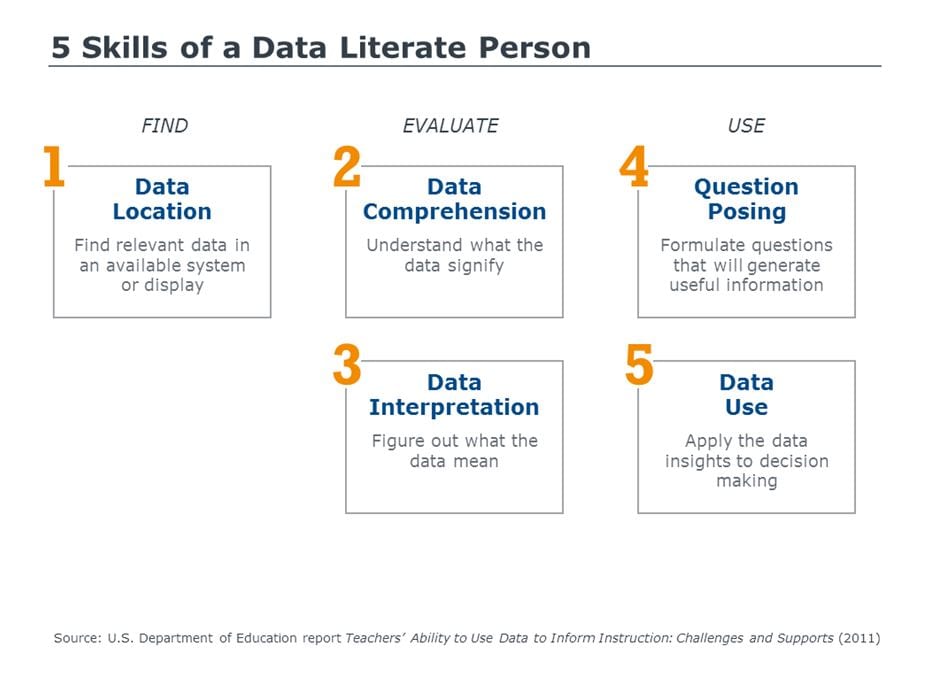Sure, your faculty and staff are all literate, but are they all data literate?
“Data literacy” has become quite a hot topic in education these days, with everyone from Forbes to Harvard to Inside Higher Ed talking about it. Most of the time, the focus is on data literacy among teachers—who use student data to improve learning outcomes—or among the students themselves—for whom data literacy is becoming a basic skill for post-graduate employment. What hasn’t gotten much air-time is the connection between data literacy and student success by way of the faculty and staff. But in my work with members of EAB’s Student Success Collaborative, data literacy has come up time and again as one of the biggest barriers to their vision of a data-enabled campus, especially when it comes to decision-making to promote student outcomes.
Taking a closer look at data literacy and student success
You don’t have to be a data scientist to be data literate. When I think of a data “savvy” person, I think of a number of things: a person who is comfortable with where the data comes from, can navigate around the different data tools available to them, and can look at various data visualizations and make a good-faith effort to interpret the trends and insights. In other places, you often find data literacy defined simply as the ability to find, evaluate, and use data in the work you do.

The problem is not everyone who is meant to be using analytics in higher education has an adequate amount of data savvy to do so. Some people call this situation a “data literacy divide,” where technology exists but human agents lack the knowledge and the skills to make use of it, blocking organizational progress. Our IT Forum experts will tell you this is a general problem across higher education, but it is a particular issue in student success because of the rapid evolution of the field. Quantitative skills have not traditionally been a part of many student support roles. In fact, until recently, many people in your average student success organization had never wanted to—or been asked to—use data in their work.

Now, I’m not talking about your “quant junkies” within the research faculty. If they are not using the student data available to them to make better decisions about how to promote student success, it’s not because they aren’t familiar with data visualization and interpretation. I’d look at other sources for their disengagement, like healthy (or unhealthy) skepticism and lack of incentives.
Instead, I’m talking about your faculty members from qualitative fields and the humanities, advisors, counselors, and even many administrators and college leaders who would rather create a PowerPoint presentation than an Excel workbook any day! A quintessential example might be the Chair of the Philosophy department. Twenty years ago, her job would have included some basic data reporting, maybe during budget processes or program evaluation. Today, we expect department chairs to use various kinds of student data to improve the academic experience of their programs, remove curricular barriers to success, and elevate faculty advising. But that expectation was never there before, and the Chair might not have the skill set to do so competently or comfortably.
Advising is similar. Advisors have over time been curriculum navigators, academic counselors, and motivational coaches—but never data analysts. Yet, today, we expect them to use data regularly to decide how to work with students, when, and with whom. It’s unsurprising that our staff may struggle to keep pace with the rapidly evolving expectations we have for them.
Promoting data literacy on campus
Given this discrepancy between our expectations for data usage and our preparation for it, any student success change management effort would not be complete without taking steps to close the data literacy divide on campus. Student success leaders must promote data familiarity and skills amongst their core groups of stakeholders if they are to achieve broad utilization and the results they are looking for.
Some of our Student Success Collaborative members are tackling the challenge head-on. Below are three examples from members as they roll out the historical ‘Institution Reports’ analytics:
1. Providing data cross-training to non-technical staff
At some universities, data savvy experts are leading a charge to bring data education to those campus constituencies who need to use it but may have never had training. Even in places where a data literacy divide exists, there are often a couple people who are expert and capable of cross-training their colleagues.For example, this spring the Lead Strategic Analyst and University Innovation Alliance Fellow from Oregon State University’s Division of Undergraduate Studies have created a new Data 101 professional development workshop. This session is designed to provide campus administrators, faculty, and staff with a 30,000-foot overview of their existing data resources for student success and how to use them. The workshop provides basic information about where the different data points come from, how to interpret what they are seeing, discussion of what they can do with the insights they find, and an invitation for units to schedule individual follow-up consultations as needed.
2. Creating spaces for collaborative data exploration
One of the most important things that leaders can do to help their staff gain data literacy is just to use their influence to create the time and the space for learning. This is exactly the kind of professional development that often slips through the cracks when folks get busy. So this spring, the student success team at the University of West Georgia has gone on an ambitious campus-wide tour to train every single academic program and department on using the Institution Reports. These trainings not only give faculty and staff the basics of how to use the tool, but also the space (and designated time) to collaboratively explore and interpret the analyses. By doing it in departmental units, faculty and staff are able to use their local context knowledge to create meaning out of the data, and less data-loving participants can learn from their savvy peers.In their most effective session, faculty from the Computer Science department trained alongside the department chair, advising staff, and the department coordinator. The training led to engaging discussion of the data from their various perspectives and even some immediate changes: adding a major GPA requirement and making a highly-predictive course a pre-req for the rest of the major.
3. Changing hiring profiles toward the tech-savvy
Many institutions say that they are in the midst of a culture shift in hiring practices. As their student support staff grows or positions turn over, student success leaders are more frequently looking for people who can balance the interpersonal and technical demands of this new era in student success. This has already started to happen naturally in the academe, as tech savvy individuals are more frequently appointed into dean roles, regardless of discipline. However, it is also happening in staff roles like advising. Advisor role descriptions and job postings are being rewritten to include responsibilities like “regularly use advising technology tools to track caseload of students” and “uses student data to guide proactive outreach and intervention.”
More Blogs

How affluent women are redefining philanthropy

What our global partners asked us most in 2025
